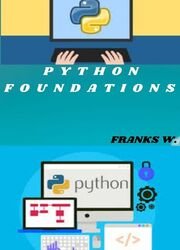Foundations Python
- Добавил: literator
- Дата: 15-12-2020, 15:21
- Комментариев: 0
 Название: Foundations Python
Название: Foundations Python Автор: Franks W.
Издательство: Amazon.com Services LLC
Год: 2020
Страниц: 333
Язык: английский
Формат: epub, azw, mobi
Размер: 10.1 MB
Learn to Program like a Superhero.
Computer programming is the art of creating applications or software. These programs allow us to do everything from solve simple math problems and watch our favorite YouTube videos (I can’t get enough of skydiving bulldogs) to destroying hordes of rampant aliens in our favorite video games and even launching a real-life spaceship into outer space. I call computer programming an "art" because it is . Anytime you create something, you are indulging in an art form. Sure, computer code, the words we type into a shell to create our programs (more on this later!), may not be pretty to look at for the common person on the street - your code will never see the inside of an art exhibit most likely - but when a part of your program does what you created it to… there is almost nothing more magical.
In this book we will stick to one of the most versatile, yet easy-to-- learn, languages, Python . While the name sounds frightening, keep in mind, it could be worse: it could be called Cobra. In truth, the language was not named after a reptile at all, but, instead, an old television comedy from Britain called Monty Python and the Flying Circus.
Python is what is known as a high-level, dynamic, interpreted, object-oriented programming language. While all of that may sound a bit intimidating, never fear! By the end of this book, you will be able to impress your friends with sentences much more daunting than the one above! All that statement really means is that Python is not a basic machine-level language, and as such, it needs an "interpreter" to "compile" it to machine language so that the computer can understand what it is you are trying to tell it. This interpreter takes your code and converts it – or compiles it – into a series of 1s and 0s that a computer can plainly understand.
Python differs from other programming languages in a number of different – yet important– ways. For starters, Python is typically easier to learn and use than languages in the same class, such as Java and C++. Programs created in Python also take less time to create, as it requires less code (in general). This is due, in part, to Python’s data types – a term we will cover in great detail in an upcoming chapter.
Python is also extremely versatile. While it may not be the primary choice, Python can be used for applications in virtually every arena, including gaming, desktop software, mobile apps, and even virtual reality. It is also a must for network programming and an essential tool in a computer security toolbox.
Скачать Foundations Python by Franks W.
Внимание
Уважаемый посетитель, Вы зашли на сайт как незарегистрированный пользователь.
Мы рекомендуем Вам зарегистрироваться либо войти на сайт под своим именем.
Уважаемый посетитель, Вы зашли на сайт как незарегистрированный пользователь.
Мы рекомендуем Вам зарегистрироваться либо войти на сайт под своим именем.
Информация
Посетители, находящиеся в группе Гости, не могут оставлять комментарии к данной публикации.
Посетители, находящиеся в группе Гости, не могут оставлять комментарии к данной публикации.
